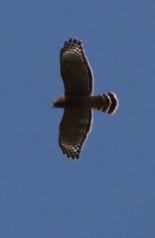We arrived to Alix Parks' home facility early, where she demonstrated the readiness of the this bird to be released. Strength in the leg and grip, healthy eater - 2 mice on this day alone, feisty aggressive attempts to fly, the ability to fly to heights, and remain perched....all part of the many things Alix checks before release. One slightly bent feather, was not enough to endanger the bird, nor the well worn feathers, showing that this bird needs to move, so that molt can occur in the near future. After a migration, it will return with bright new feathers in the fall, but if not released, it might be forced to remain state-side for the winter. It needed to be released into the migration, even if a bit late.
Alex was as anxious as was the bird, to get it going, hoping to see it join others kettling above Signal Point, where it would be released. That had happened once before. But it wasn't to be, on Thursday afternoon. For we saw no BW's in the nearby skies. But not to fear, it wasn't necessary. Broad-wings, which love to join a migratory group kettling into a rising thermal, are generally loners, and will fly one by one as well. All Pucara needs is the yearning that draws migrating birds around the globe, to go to warmer climates as winter approaches. That amazing yearning, so fascinating, and barely understood.
 As Jimmy and I entered the large enclosure that provides protection and containment, while allowing for ample flight to assure the continued health or healing thereof, for injured raptors, I was impressed. Alix had provided anything a healing bird could need. I searched the high spots, desiring to see this bird that I recognized from the heights of a blue sky, curious to see it up close and personal. Would I recognize it?
As Jimmy and I entered the large enclosure that provides protection and containment, while allowing for ample flight to assure the continued health or healing thereof, for injured raptors, I was impressed. Alix had provided anything a healing bird could need. I searched the high spots, desiring to see this bird that I recognized from the heights of a blue sky, curious to see it up close and personal. Would I recognize it?I spotted it through the branches of a small tree, and the illusion while it sat up high was of a larger bird than when it is actually in hand. I was actually surprised to see it's body up close. Those enormous wings in comparison to it's body confirmed how well it's named.
Alix points to the Crop of this bird, which is protruding because it is full. It devoured 2 mice after all, earlier. (also known as Croup, or Craw, and I 've also heard it pronounced, Crawp)
In the picture above two things are visible that we expect to see on a Broad-winged Hawk.
- There is a silvery-ness on the outer under-wing. In the air, as this bird banks in flight, sunlight that catches that area of the wing creates a silver flash. This is extremely helpful, when we are looking at miniscule kettles far away or high in the sky. It is possible to know we are seeing Broad-wings rather than Vultures, for instance, by that flash. In our area, generally, only Vultures occur in enough numbers to make a kettle of any size, although I once saw a small kettle of Eagles. (Hope that we see more of those.) In a mixed kettle, the size often becomes obvious as we watch the birds bank and turn. But without the benefit of larger birds in the kettle, we must make a decision on distant birds based on more than perceived size. The flashes of silver will look a bit like glitter, especially in a haze. But it brings confidence in our calls, when we are counting vanishing specks.
- In the same vein, there is a white under-rump on this bird, that is our second element, which helps ID these birds in a mix. Buteos can sometimes display very similar silhouettes. It can take a bit of watching the birds as they approach, and even after years of counting, all of us, ALL OF US, go back and forth on what we are seeing sometimes. But more than once, we have used the "white flash" that occurs as Broad-wings bank and flip in flight, to determine if we are seeing Broad-wings or Red-shouldered hawks, for example.
So - White flash at rump, and silver flash on the outer underwing. Sometimes you can see only one or the other, depending on the light and sun angle, but sometimes you can clearly see both.
 |
| Broad-winged Hawk above Red-shouldered Hawk below |
Compare in the pictures here, the Broad-wing above, with the silver flash out near the tip of the very pointed, "paring knife shaped wing, to the much rounder wing with a transparent "window" or "comma" on the outer wing of a Red-shouldered hawk, below. Both have intense banding in the tail, but the bold bands on the short wide tail of the Broad-wing, make it seem more obvious, or more singular. As if it has only one wide white band. Notice the white on the under rump. Both have reddish, (considered "chocolate" on the BW) heads sometimes, and in fact, a Broad-wing can have the transparent windows in the wing, if it is an immature bird. Some of these things we will discuss further in our next blog.
Consider this Part I on the identification of Broad-winged Hawks, and keep coming back for more as we discuss how we know this bird's age in Part II.
And always ----
Keep Looking UP!!!!http://soddymountainhawkwatch.blogspot.com/p/rehabrelease.html





No comments:
Post a Comment